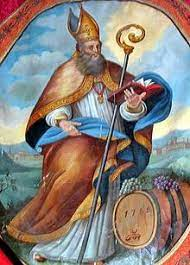 Saint Omer
Saint Omer
Bishop of Therouanne France († 670)
Feast – September 9
On February 27, 380, in Thessaloniki, the Eastern Roman Emperor Theodosius I signed a decree in the presence of the Western Roman Emperor Valentinian II that made Christianity the religion of the state and punished the practice of pagan rituals. The entire Roman empire from Egypt and North Africa, to Britain; from Asia minor to Spain; the entire civilized world worshipped the same, one true God. However, the Roman Empire was in decline. Germanic tribes of Goths had invaded the Roman Empire on and off since 238. In the second half of the fourth century this invasion in the form of illegal immigration intensified. This created animosity towards them among the Roman population. The Goths began looting and pillaging throughout the eastern Balkans. At the Battle of Adrianople in 378, they defeated the Roman army and killed emperor Valens. The new Eastern emperor, Theodosius I, signed a treaty which made them subjects of the empire as foederati (autonomous mercenary troops of the Roman Army) known as the Visigoths.
They were allotted the northern part of the dioceses of Dacia and Thrace. In 410 they sacked the heart and largest city of the Western Empire, Rome. Slowly acquiring an independent and perpetual inheritance in Gaul, Spain, and Africa they were weakening the Western Roman Empire in the process. In 476 under the leadership of Flavius Odoacer, who went by the name of Herulians foederati, started a revolt. They insisted that a third part of the lands of Italy should be immediately divided among them. Their demand was rejected by Orestes, the father of Emperor. The decisive battle was fought on September 2nd, 476 at Ravenna, the capital of the Western Roman Empire. Foederati defeated the largely depleted Roman garrison, capturing the city swiftly and easily. Two days later, the sixteen-year-old Emperor Romulus Augustulus was forced to abdicate by Odoacer, ending twelve-hundred years of Roman rule in Italy. In 554 the Emperor Justinian formally dissolved the Western imperial court. This created tension and led to power struggles in different regions of the former Western Roman Empire. Christianity was no longer protected by the government. One of the affected regions was the county of Artois. In 1180 it was annexed by the county of Flanders and became of part of the original twelve peers of the Kingdom of France. Today it is split between France, Netherlands and Belgium.
In the 7th century the majority of inhabitants in the Artois region, regularly ravaged by the Saxons (Germanic coastal raiders), were still pagans. The lack of stability and shortage of priests even led to some of the remaining Christians to lapse in the faith.
Saint Omer was born toward the close of the sixth century in the territory of Constance, southwestern Germany where the Rhine River flows out of Lake Constance. His parents, who were noble and wealthy, paid great attention to his education, but, above all, strove to inspire him with a love for virtue. Upon the death of his mother, he entered the monastery of Luxeuil. Luxeuil Abbey, which was dedicated to St. Peter and St. Paul, was founded in 585 by the great Irish monk, St. Columbanus. Located in what is now the department of Haute-Saone in France, it quickly became the best-known, flourishing and most influential monastery in Burgundy.
Soon his father, after selling their worldly goods and distributing the proceeds among the poor accompanied him. The father and son made their religious profession together.
The extraordinary humility, obedience, mildness, and devotion, together with the admirable purity of intention which shone forth in every action of St. Omer, distinguished him among his brethren. The opinion of his sanctity and intellectual abilities left the walls of the abbey, and he was chosen to establish the diocese Therouanne around the year 639.
While facing pagans as the Bishop of his Therouanne, St. Omer understood the enormous responsibility laid upon him and applied himself to the task with such efficacious zeal that the diocese became the most flourishing in France at the time. A pagan overlord who had persecuted the Christians could not resist the exhortations of the holy bishop and after his baptism gave large grants to the church; on one of those terrains the bishop built a monastery in honor of the Blessed Virgin. After governing his church for nearly thirty years, St. Omer in his old age became blind, but that affliction did not lessen his pastoral concern for his flock. He died in the odor of sanctity while on a pastoral visit, in the year 670. Twelve centuries lather St. John Vianney said “In heaven the saints are happy, but they are like capitalists who worked diligently, and now live on their earnings.” St. Omer serving God to his last breath is a perfect example of one.
References and Excerpts:
[1] “Saint Omer, Bishop of Therouanne.” https://sanctoral.com/en/saints/saint_omer.html (accessed Aug. 31, 2021).
[2] “Ancient Diocese of Thérouanne,” Wikipedia. Jan. 16, 2021. Accessed: Aug. 31, 2021. [Online]. Available: https://en.wikipedia.org/w/index.php?title=Ancient_Diocese_of_Th%C3%A9rouanne&oldid=1000716110
[3] “Battle of Ravenna (476),” Wikipedia. Aug. 30, 2021. Accessed: Aug. 31, 2021. [Online]. Available: https://en.wikipedia.org/w/index.php?title=Battle_of_Ravenna_(476)&oldid=1041374209